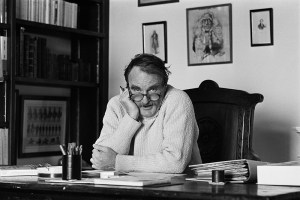The hamburger is the perfect meal in the hand, eaten by workers on their lunch breaks, or by families who cannot afford fancy restaurants. It is the great comestible leveler, suitable alike for suburban barbecues and the front steps of tenement houses. The staple food of American democracy yields cheeseburgers, baconburgers, franchise brands, and drive-in outlets with total annual sales of five billion units. The precise origins of the patty, however, remain opaque.
Nobody knows for certain who first thought of cooking a patty of minced beef and serving it inside a fresh-baked bun. The earliest use of the name was for an 11-cent dish, the ‘Hamburger steak’, served at a New York restaurant, Delmonico’s, in 1873. There is no mention of buns or relish. The first recipe for the Hamburg steak, in Mrs Lincoln’s Boston Cook Book of 1884, was also bun-free.
A hamburger joint in Seymour, Wisconsin claims to have served one in 1885 at a fair in Hamburg, New York. A further claim is made for Louis Lassen of New Haven, Connecticut, who in 1900 slapped two slices of bread around hot fried beef. The Chicago Daily News in 1896 reports a ‘hamburger sandwich’ being sold from a cart.
None of these accounts has independent corroboration. Such evidence as there is points to the German city from which the Hamburger takes its name, and to the most significant ethnic influx into the United States since the Irish Potato Famine of the 1840s: the mass immigration of eastern European Jews that followed the Russian pogroms of 1881.
For most Jews in 19th-century Eastern Europe, America was an unattainable dream. The cost of a third-class ship passage was $125, plus the cost of traveling from home to the point of embarkation. Every step was fraught with hazard.
‘It was two o’clock in the morning when my guide, whose business it was to smuggle out travelers without passports to Germany, called for me,’ recalled Benjamin L. Gordon of Neustadt, Lithuania. ‘After walking silently in the dark for about an hour we reached a forest near the frontier…from behind trees we could see the guards marching to and fro…we heard the shots of revolvers.’
The main departure point for Jewish migrants was Hamburg, where exit numbers reached a record of 123,000 in 1881. In the same year, the Lloyd company of Germany introduced the Schnelldampfer, a modern liner that cut the transatlantic journey from 22 days to 14, and then to nine. As fares fell and the number of passengers rose, a teenage school dropout spotted an opportunity.
Albert Ballin was the 13th child of the owner of a struggling Hamburg travel agency. When his father died, Albert, then 17, took over the company. Instead of selling tickets for other operators, he launched his own line. Ballin persuaded a British shipowner, Edward Carr, to convert two cargo ships into passenger vessels. Dispensing with first-class cabins, they crammed in 640 passengers and cut prices by a third. Within a year, Ballin had 17 percent of the emigration trade.
By the time he was 29, Hapag, Hamburg’s biggest shipping line, had recruited him at a salary of 100,000 marks to run its North American business. Soon he was president of Hapag, head of the German shipping industry and trusted friend of the emperor, Wilhelm II. Under Ballin’s command Hapag set the transatlantic standard for on-board refreshment. The Hamburg authorities regulated conditions on board, specifying minimum bunk space and food per passenger — mostly rusks and salted pork. But to Jewish migrants, Albert Ballin fed kosher food: beef properly slaughtered and salted according to rabbinic rules. Minced and packed, it was frozen as individual portions and quickly flamed into food.
Food historians suggest the hamburger was created by Hamburg shipping lines to feed passengers fast and cheaply; others contend it was devised in America by ex-Hamburg passengers. The former supposition is more likely. In the absence of conclusive evidence to the contrary, I suggest that Albert Ballin of Hamburg invented the American hamburger.
Ballin, a shy workaholic who banned the Hapag press department from publishing anything about him, took no credit for his culinary innovation. He had bigger geopolitical ambitions. His motto was ‘The world is my field’. His world, like that of many other Jewish pioneers, was destroyed in 1914 when his friend Kaiser Wilhelm precipitated World War One.
Norman Lebrecht’s new book Genius and Anxiety: How the Jews Changed the World, 1847-1947 is published by Scribner. This article is in The Spectator’s January 2020 US edition.

























